The Cambridge History of Japan, Vol. 1: Ancient Japan
Подождите немного. Документ загружается.

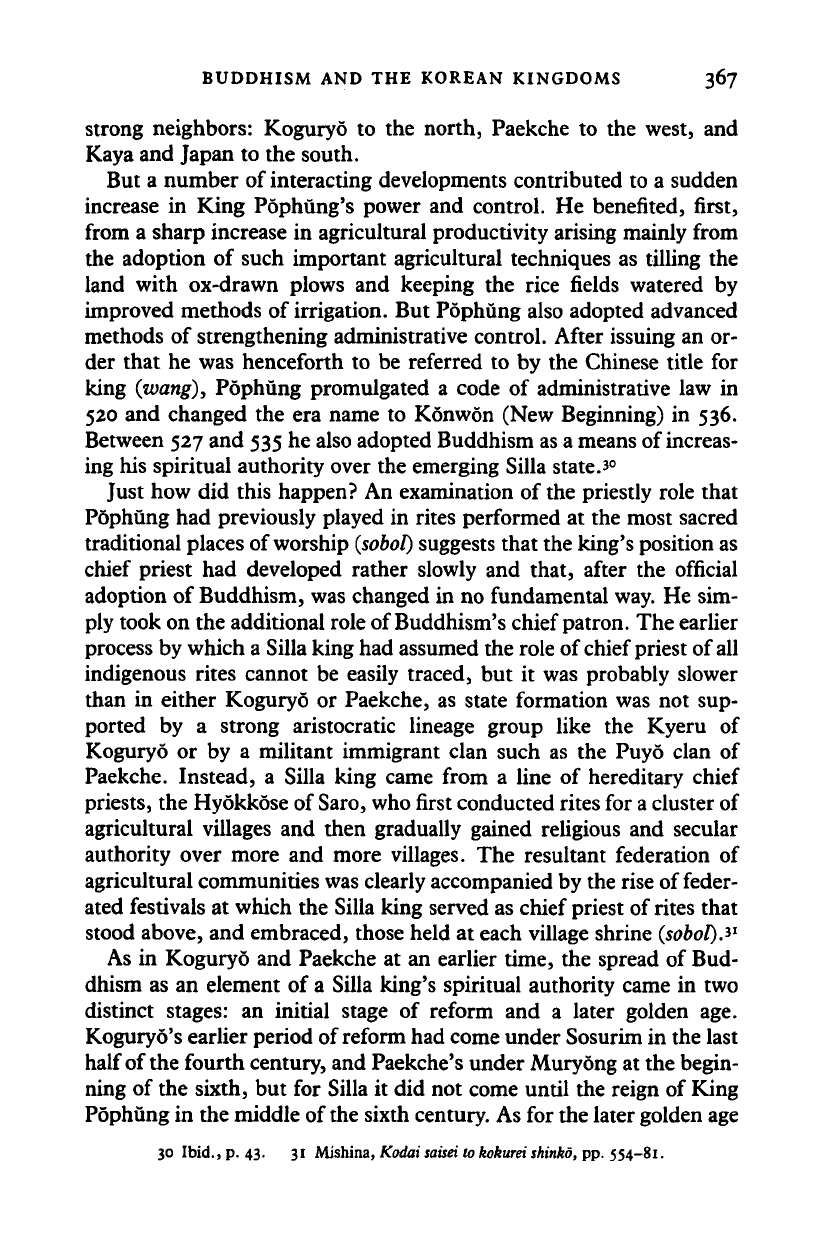
BUDDHISM AND THE KOREAN KINGDOMS 367
strong neighbors: Koguryo to the north, Paekche to the west, and
Kaya and Japan to the south.
But a number of interacting developments contributed to a sudden
increase in King Pophung's power and control. He benefited, first,
from a sharp increase in agricultural productivity arising mainly from
the adoption of such important agricultural techniques as tilling the
land with ox-drawn plows and keeping the rice fields watered by
improved methods of irrigation. But Pophung also adopted advanced
methods of strengthening administrative control. After issuing an or-
der that he was henceforth to be referred to by the Chinese title for
king (wang), Pophung promulgated a code of administrative law in
520 and changed the era name to Konwon (New Beginning) in 536.
Between 527 and 535 he also adopted Buddhism as a means of increas-
ing his spiritual authority over the emerging Silla stated
0
Just how did this happen? An examination of the priestly role that
Pophung had previously played in rites performed at the most sacred
traditional places of worship
(sobol)
suggests that the king's position as
chief priest had developed rather slowly and that, after the official
adoption of Buddhism, was changed in no fundamental way. He sim-
ply took on the additional role of Buddhism's chief patron. The earlier
process by which a Silla king had assumed the role of chief priest of all
indigenous rites cannot be easily traced, but it was probably slower
than in either Koguryo or Paekche, as state formation was not sup-
ported by a strong aristocratic lineage group like the Kyeru of
Koguryo or by a militant immigrant clan such as the Puyo clan of
Paekche. Instead, a Silla king came from a line of hereditary chief
priests, the Hyokkose of
Saro,
who
first
conducted rites for
a
cluster of
agricultural villages and then gradually gained religious and secular
authority over more and more villages. The resultant federation of
agricultural communities was clearly accompanied by the rise of feder-
ated festivals at which the Silla king served as chief priest of rites that
stood above, and embraced, those held at each village shrine (so&o/)-
31
As in Koguryo and Paekche at an earlier time, the spread of Bud-
dhism as an element of a Silla king's spiritual authority came in two
distinct stages: an initial stage of reform and a later golden age.
Koguryo's earlier period of reform had come under Sosurim in the last
half of the fourth century, and Paekche's under Muryong at the begin-
ning of the sixth, but for Silla it did not come until the reign of King
Pophung in the middle of the sixth century. As for the later golden age
30 Ibid., p. 43. 31 Mishina, Kodai
saisei
to
kokurei
shinko,
pp. 554-81.
Cambridge Histories Online © Cambridge University Press, 2008
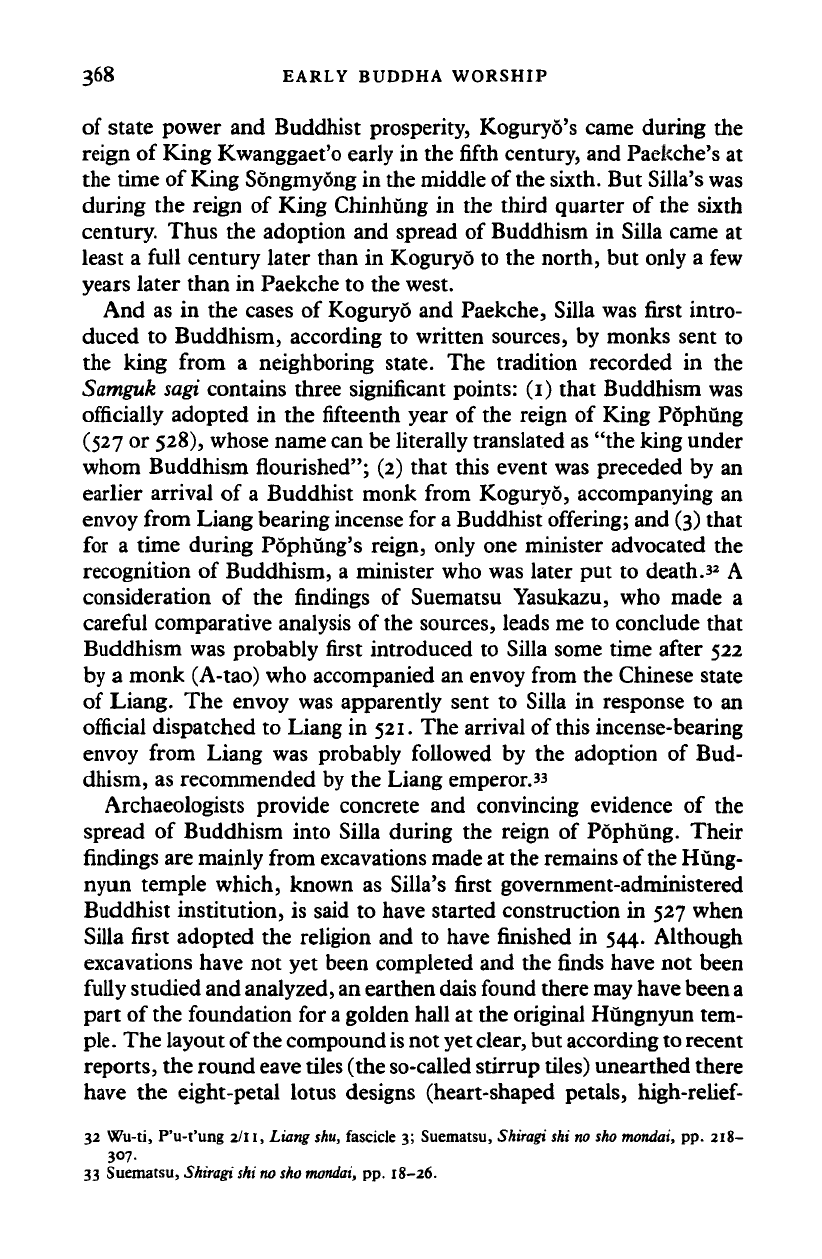
368 EARLY BUDDHA WORSHIP
of state power and Buddhist prosperity, Koguryo's came during the
reign of King Kwanggaet'o early in the fifth century, and Paekche's at
the time of King Songmyong in the middle of
the
sixth. But Silla's was
during the reign of King Chinhung in the third quarter of the sixth
century. Thus the adoption and spread of Buddhism in Silla came at
least a full century later than in Koguryo to the north, but only a few
years later than in Paekche to the west.
And as in the cases of Koguryo and Paekche, Silla was first intro-
duced to Buddhism, according to written sources, by monks sent to
the king from a neighboring state. The tradition recorded in the
Samguk sagi contains three significant points: (i) that Buddhism was
officially adopted in the fifteenth year of the reign of King Pophung
(527 or 528), whose name can be literally translated as "the king under
whom Buddhism flourished"; (2) that this event was preceded by an
earlier arrival of a Buddhist monk from Koguryo, accompanying an
envoy from Liang bearing incense for a Buddhist offering; and (3) that
for a time during Pophung's reign, only one minister advocated the
recognition of Buddhism, a minister who was later put to deaths A
consideration of the findings of Suematsu Yasukazu, who made a
careful comparative analysis of the sources, leads me to conclude that
Buddhism was probably first introduced to Silla some time after 522
by a monk (A-tao) who accompanied an envoy from the Chinese state
of Liang. The envoy was apparently sent to Silla in response to an
official dispatched to Liang in
521.
The arrival of
this
incense-bearing
envoy from Liang was probably followed by the adoption of Bud-
dhism, as recommended by the Liang emperor.33
Archaeologists provide concrete and convincing evidence of the
spread of Buddhism into Silla during the reign of Pophung. Their
findings are mainly from excavations made at the remains of the Hung-
nyun temple which, known as Silla's first government-administered
Buddhist institution, is said to have started construction in 527 when
Silla first adopted the religion and to have finished in 544. Although
excavations have not yet been completed and the finds have not been
fully studied and analyzed, an earthen dais found there may have been
a
part of the foundation for
a
golden hall at the original Hungnyun tem-
ple.
The layout of the compound
is
not yet
clear,
but according
to
recent
reports, the round eave tiles (the so-called stirrup tiles) unearthed there
have the eight-petal lotus designs (heart-shaped petals,
high-relief-
32 Wu-ti, P'u-t'ung 2/11, Liang
shu,
fascicle 3; Suematsu, Shiragi shi no sho mondai, pp. 218-
307.
33 Suematsu, Shiragi shi no sho
mondai,
pp. 18-26.
Cambridge Histories Online © Cambridge University Press, 2008
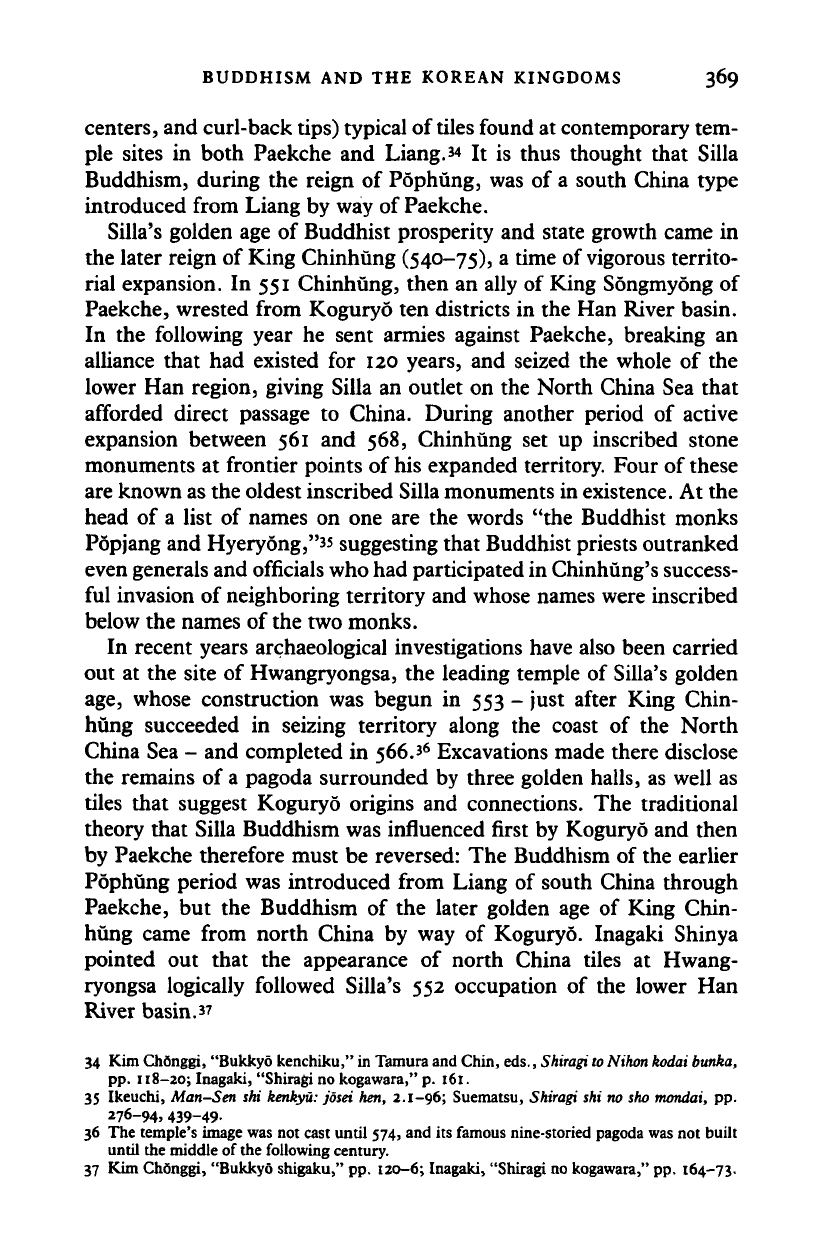
BUDDHISM AND THE KOREAN KINGDOMS 369
centers, and curl-back tips) typical of
tiles
found at contemporary tem-
ple sites in both Paekche and Liang. 34 It is thus thought that Silla
Buddhism, during the reign of Pophung, was of a south China type
introduced from Liang by way of Paekche.
Silla's golden age of Buddhist prosperity and state growth came in
the later reign of King Chinhung (540-75), a time of vigorous territo-
rial expansion. In 551 Chinhung, then an ally of King Songmyong of
Paekche, wrested from Koguryo ten districts in the Han River basin.
In the following year he sent armies against Paekche, breaking an
alliance that had existed for 120 years, and seized the whole of the
lower Han region, giving Silla an outlet on the North China Sea that
afforded direct passage to China. During another period of active
expansion between 561 and 568, Chinhung set up inscribed stone
monuments at frontier points of his expanded territory. Four of these
are known as the oldest inscribed Silla monuments in existence. At the
head of a list of names on one are the words "the Buddhist monks
Popjang and Hyeryong,"35 suggesting that Buddhist priests outranked
even generals and officials who had participated in Chinhung's success-
ful invasion of neighboring territory and whose names were inscribed
below the names of the two monks.
In recent years archaeological investigations have also been carried
out at the site of Hwangryongsa, the leading temple of Silla's golden
age,
whose construction was begun in 553 - just after King Chin-
hung succeeded in seizing territory along the coast of the North
China Sea - and completed in
566.3
s
Excavations made there disclose
the remains of
a
pagoda surrounded by three golden halls, as well as
tiles that suggest Koguryo origins and connections. The traditional
theory that Silla Buddhism was influenced first by Koguryo and then
by Paekche therefore must be reversed: The Buddhism of the earlier
Pophung period was introduced from Liang of south China through
Paekche, but the Buddhism of the later golden age of King Chin-
hung came from north China by way of Koguryo. Inagaki Shinya
pointed out that the appearance of north China tiles at Hwang-
ryongsa logically followed Silla's 552 occupation of the lower Han
River basin.37
34 Kim ChOnggi, "Bukkyo kenchiku," in Tamura and Chin, eds., Shiragi
to
Nihon kodai bunka,
pp.
118-20; Inagaki, "Shiragi no kogawara," p. 161.
35 Ikeuchi, Man-Sen shi kenkyu: josei hen, 2.1-96; Suematsu, Shiragi ski no sho mondai, pp.
276-94,
439-49-
36 The temple's image was not cast until 574, and its famous nine-storied pagoda was not built
until the middle of the following century.
37 Kim Chdnggi, "Bukkyo shigaku," pp. 120-6; Inagaki, "Shiragi no kogawara," pp. 164-73.
Cambridge Histories Online © Cambridge University Press, 2008
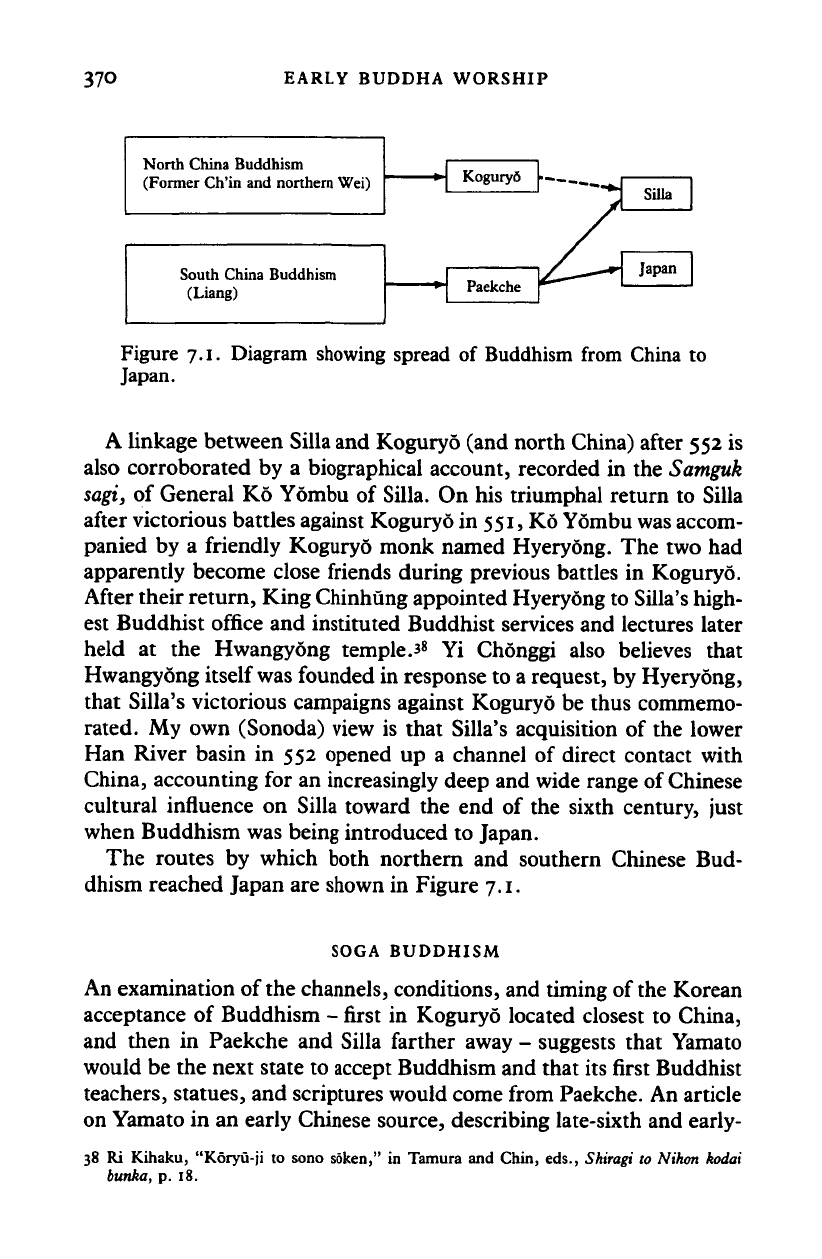
37O
EARLY BUDDHA WORSHIP
North China Buddhism
(Former Ch'in and northern Wei)
Koguryd
South China Buddhism
(Liang)
Paekche
Figure 7.1. Diagram showing spread of Buddhism from China to
Japan.
A linkage between Silla and Koguryo (and north China) after 552 is
also corroborated by a biographical account, recorded in the
Samguk
sagi, of General K6 Yombu of Silla. On his triumphal return to Silla
after victorious battles against Koguryo in
551,
K6 Yombu was accom-
panied by a friendly Koguryo monk named Hyeryong. The two had
apparently become close friends during previous battles in Koguryo.
After their return, King Chinhung appointed Hyeryong to Silla's high-
est Buddhist office and instituted Buddhist services and lectures later
held at the Hwangyong temple. *
8
Yi Chonggi also believes that
Hwangyong itself
was
founded in response to a request, by Hyeryong,
that Silla's victorious campaigns against Koguryo be thus commemo-
rated. My own (Sonoda) view is that Silla's acquisition of the lower
Han River basin in 552 opened up a channel of direct contact with
China, accounting for an increasingly deep and wide range of Chinese
cultural influence on Silla toward the end of the sixth century, just
when Buddhism was being introduced to Japan.
The routes by which both northern and southern Chinese Bud-
dhism reached Japan are shown in Figure 7.1.
SOGA BUDDHISM
An examination of the channels, conditions, and timing of the Korean
acceptance of Buddhism - first in Koguryo located closest to China,
and then in Paekche and Silla farther away - suggests that Yamato
would be the next state to accept Buddhism and that its first Buddhist
teachers, statues, and scriptures would come from Paekche. An article
on Yamato in an early Chinese source, describing late-sixth and early-
38 Ri Kihaku, "K6ryu-ji to sono soken," in Tamura and Chin, eds., Shiragi to Nikon kodai
bunka, p. 18.
Cambridge Histories Online © Cambridge University Press, 2008
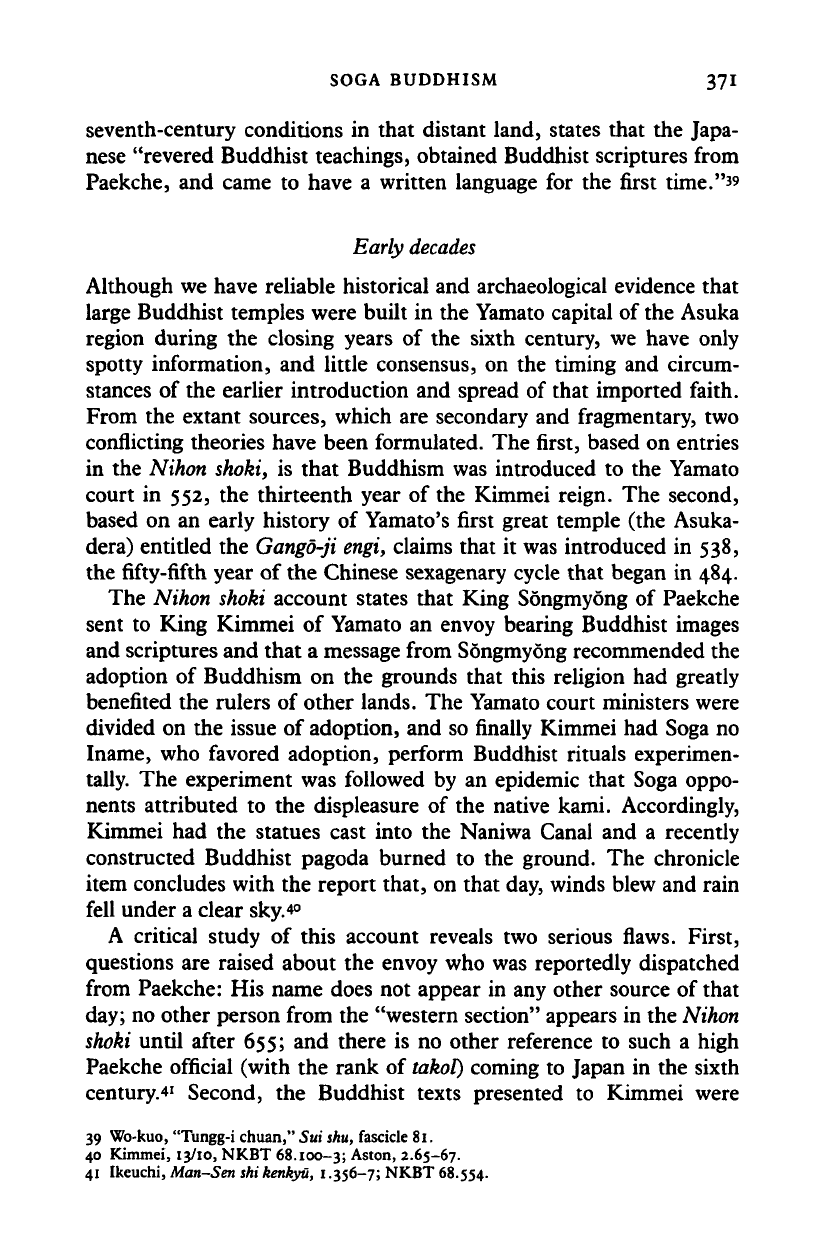
SOGA BUDDHISM 371
seventh-century conditions in that distant land, states that the Japa-
nese "revered Buddhist teachings, obtained Buddhist scriptures from
Paekche, and came to have a written language for the first time."39
Early
decades
Although we have reliable historical and archaeological evidence that
large Buddhist temples were built in the Yamato capital of the Asuka
region during the closing years of the sixth century, we have only
spotty information, and little consensus, on the timing and circum-
stances of the earlier introduction and spread of that imported faith.
From the extant sources, which are secondary and fragmentary, two
conflicting theories have been formulated. The first, based on entries
in the Nikon shoki, is that Buddhism was introduced to the Yamato
court in 552, the thirteenth year of the Kimmei reign. The second,
based on an early history of Yamato's first great temple (the Asuka-
dera) entitled the
Gango-ji
engi,
claims that it was introduced in 538,
the fifty-fifth year of the Chinese sexagenary cycle that began in 484.
The Nihon shoki account states that King Songmyong of Paekche
sent to King Kimmei of Yamato an envoy bearing Buddhist images
and scriptures and that a message from Songmyong recommended the
adoption of Buddhism on the grounds that this religion had greatly
benefited the rulers of other lands. The Yamato court ministers were
divided on the issue of adoption, and so finally Kimmei had Soga no
Iname, who favored adoption, perform Buddhist rituals experimen-
tally. The experiment was followed by an epidemic that Soga oppo-
nents attributed to the displeasure of the native kami. Accordingly,
Kimmei had the statues cast into the Naniwa Canal and a recently
constructed Buddhist pagoda burned to the ground. The chronicle
item concludes with the report that, on that day, winds blew and rain
fell under a clear sky/
0
A critical study of this account reveals two serious flaws. First,
questions are raised about the envoy who was reportedly dispatched
from Paekche: His name does not appear in any other source of that
day; no other person from the "western section" appears in the Nihon
shoki
until after 655; and there is no other reference to such a high
Paekche official (with the rank of
takot)
coming to Japan in the sixth
century.4
1
Second, the Buddhist texts presented to Kimmei were
39 Wo-kuo, "Tungg-i chuan," Sui
shu,
fascicle 81.
40 Kimmei, 13/10, NKBT 68.100-3; Aston, 2.65-67.
41 Ikeuchi, Man-Sen shi'kenkyii, 1.356-7; NKBT 68.554.
Cambridge Histories Online © Cambridge University Press, 2008
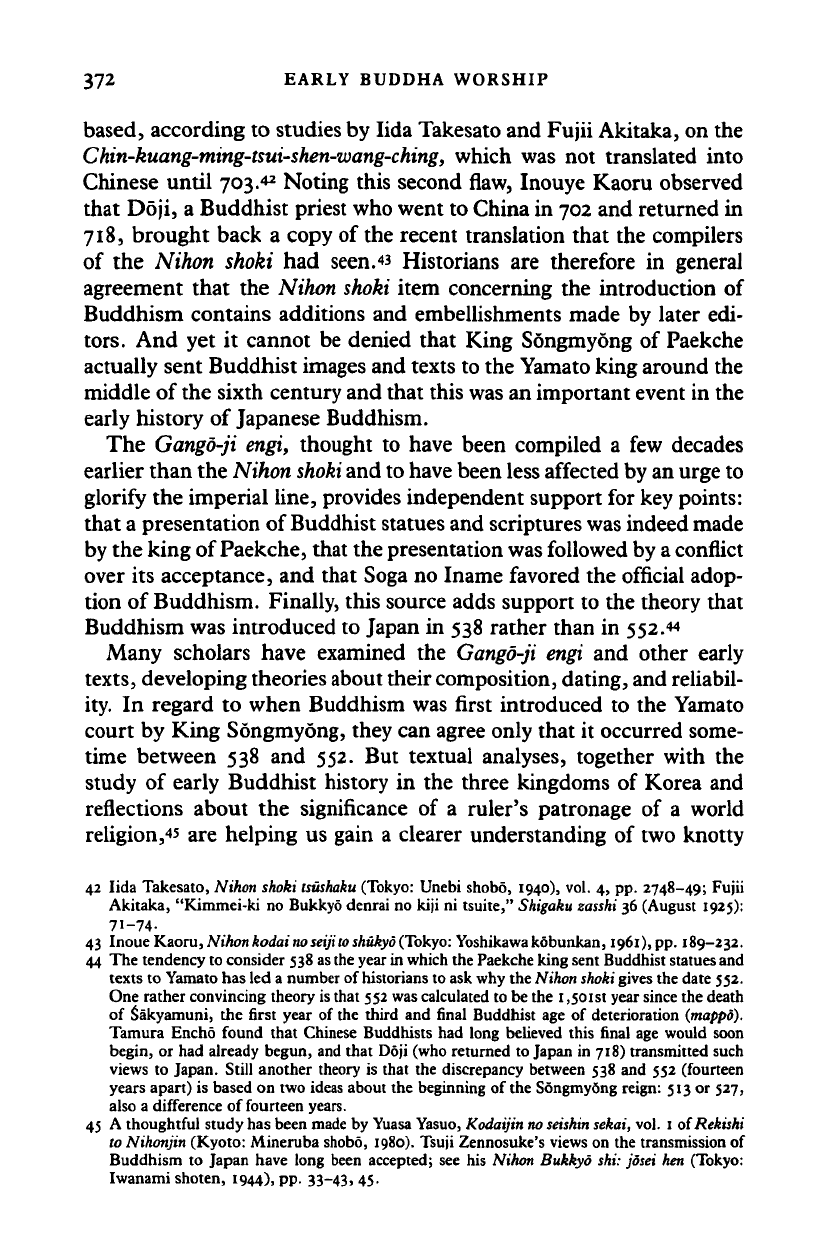
372 EARLY BUDDHA WORSHIP
based, according to studies by Iida Takesato and Fujii Akitaka, on the
Chin-kuang-ming-tsui-shen-wang-ching,
which was not translated into
Chinese until 703.^ Noting this second flaw, Inouye Kaoru observed
that Doji, a Buddhist priest who went to China in 702 and returned in
718,
brought back a copy of the recent translation that the compilers
of the Nihon shoki had seen.« Historians are therefore in general
agreement that the Nihon
shoki
item concerning the introduction of
Buddhism contains additions and embellishments made by later edi-
tors.
And yet it cannot be denied that King Songmyong of Paekche
actually sent Buddhist images and texts to the Yamato king around the
middle of the sixth century and that this was an important event in the
early history of Japanese Buddhism.
The Gango-ji engi, thought to have been compiled a few decades
earlier than the Nihon
shoki
and to have been less affected by an urge to
glorify the imperial line, provides independent support for key points:
that a presentation of Buddhist statues and scriptures was indeed made
by the king of Paekche, that the presentation was followed by
a
conflict
over its acceptance, and that Soga no Iname favored the official adop-
tion of Buddhism. Finally, this source adds support to the theory that
Buddhism was introduced to Japan in 538 rather than in 552.+*
Many scholars have examined the
Gango-ji
engi and other early
texts,
developing theories about their composition, dating, and reliabil-
ity. In regard to when Buddhism was first introduced to the Yamato
court by King Songmyong, they can agree only that it occurred some-
time between 538 and 552. But textual analyses, together with the
study of early Buddhist history in the three kingdoms of Korea and
reflections about the significance of a ruler's patronage of a world
religion,45 are helping us gain a clearer understanding of two knotty
42 Iida Takesato, Nihon shoki
tsushaku
(Tokyo: Unebi shobo, 1940), vol. 4, pp. 2748-49; Fujii
Akitaka, "Kimmei-ki no Bukkyo denrai no kiji ni tsuite," Shigaku zasshi 36 (August 1925):
71-74-
43 Inoue Kaoru, Nihonkodainoseijitoshukyo(Tokyo: Yoshikawakobunkan, 1961), pp. 189-232.
44 The tendency to consider 538 as the year in which the Paekche king sent Buddhist statues and
texts to Yamato has led a number of historians to ask why the Nihon
shoki
gives the date 552.
One rather convincing theory is that 552 was calculated to be the 1,501st year since the death
of Sakyamuni, the first year of the third and final Buddhist age of deterioration (mappo).
Tamura Encho found that Chinese Buddhists had long believed this final age would soon
begin, or had already begun, and that Doji (who returned to Japan in 718) transmitted such
views to Japan. Still another theory is that the discrepancy between 538 and 552 (fourteen
years apart) is based on two ideas about the beginning of the Songmyong reign: 513 or 527,
also a difference of fourteen yean.
45 A thoughtful study has been made by Yuasa Yasuo, Kodaijin
no seishin
sekai, vol. 1 oiRekishi
to Nihonjin (Kyoto: Mineruba shobo, 1980). Tsuji Zennosuke's views on the transmission of
Buddhism to Japan have long been accepted; see his Nihon Bukkyo shi: jdsei hen (Tokyo:
Iwanami shoten, 1944), pp. 33-43, 45.
Cambridge Histories Online © Cambridge University Press, 2008
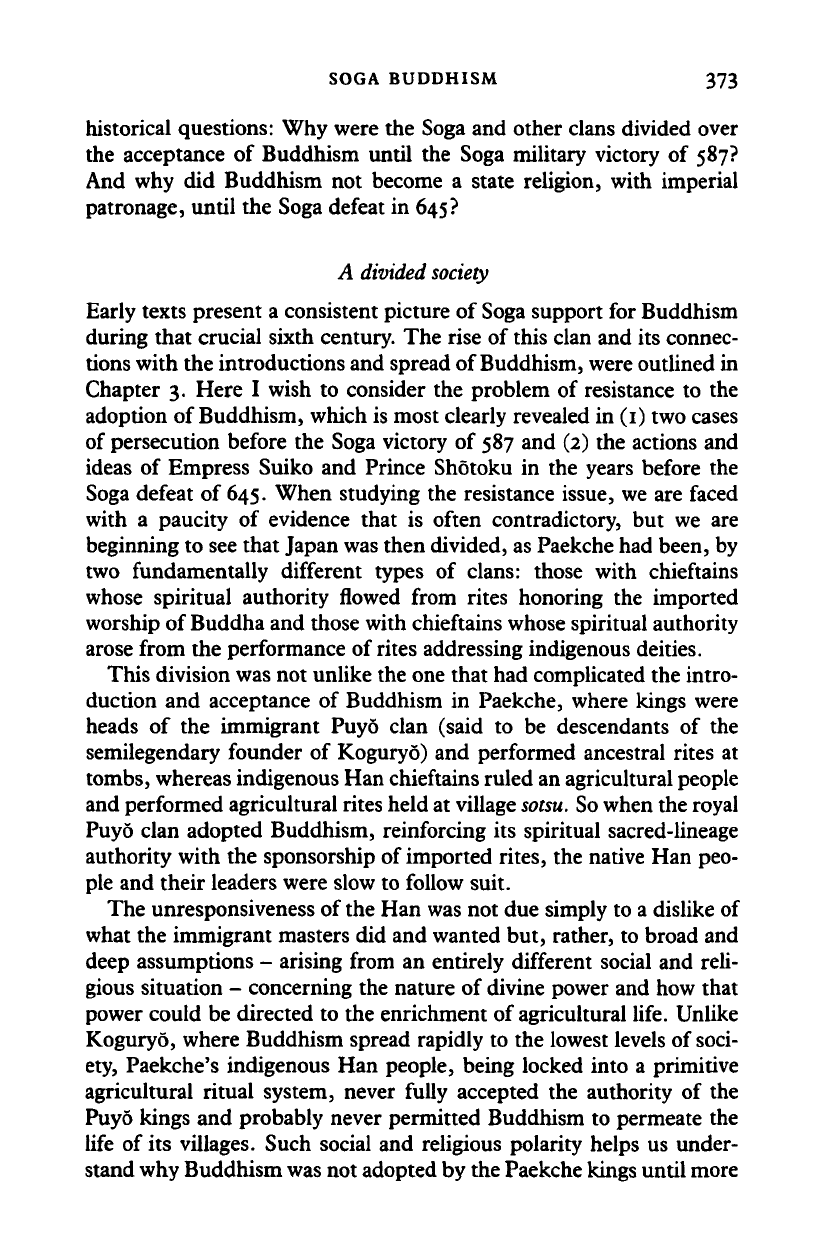
SOGA BUDDHISM 373
historical questions: Why were the Soga and other clans divided over
the acceptance of Buddhism until the Soga military victory of 587?
And why did Buddhism not become a state religion, with imperial
patronage, until the Soga defeat in 645?
A divided
society
Early texts present a consistent picture of Soga support for Buddhism
during that crucial sixth century. The rise of this clan and its connec-
tions with the introductions and spread of Buddhism, were outlined in
Chapter 3. Here I wish to consider the problem of resistance to the
adoption of Buddhism, which is most clearly revealed in (1) two cases
of persecution before the Soga victory of 587 and (2) the actions and
ideas of Empress Suiko and Prince Shotoku in the years before the
Soga defeat of
645.
When studying the resistance issue, we are faced
with a paucity of evidence that is often contradictory, but we are
beginning to see that Japan was then divided, as Paekche had been, by
two fundamentally different types of clans: those with chieftains
whose spiritual authority flowed from rites honoring the imported
worship of Buddha and those with chieftains whose spiritual authority
arose from the performance of rites addressing indigenous deities.
This division was not unlike the one that had complicated the intro-
duction and acceptance of Buddhism in Paekche, where kings were
heads of the immigrant Puyo clan (said to be descendants of the
semilegendary founder of Koguryo) and performed ancestral rites at
tombs, whereas indigenous Han chieftains ruled an agricultural people
and performed agricultural rites held at village
sotsu.
So
when the royal
Puyo clan adopted Buddhism, reinforcing its spiritual sacred-lineage
authority with the sponsorship of imported rites, the native Han peo-
ple and their leaders were slow to follow suit.
The unresponsiveness of the Han was not due simply to a dislike of
what the immigrant masters did and wanted but, rather, to broad and
deep assumptions - arising from an entirely different social and reli-
gious situation - concerning the nature of divine power and how that
power could be directed to the enrichment of agricultural life. Unlike
Koguryo, where Buddhism spread rapidly to the lowest levels of soci-
ety, Paekche's indigenous Han people, being locked into a primitive
agricultural ritual system, never fully accepted the authority of the
Puyo kings and probably never permitted Buddhism to permeate the
life of its villages. Such social and religious polarity helps us under-
stand why Buddhism
was
not adopted by the Paekche kings until more
Cambridge Histories Online © Cambridge University Press, 2008
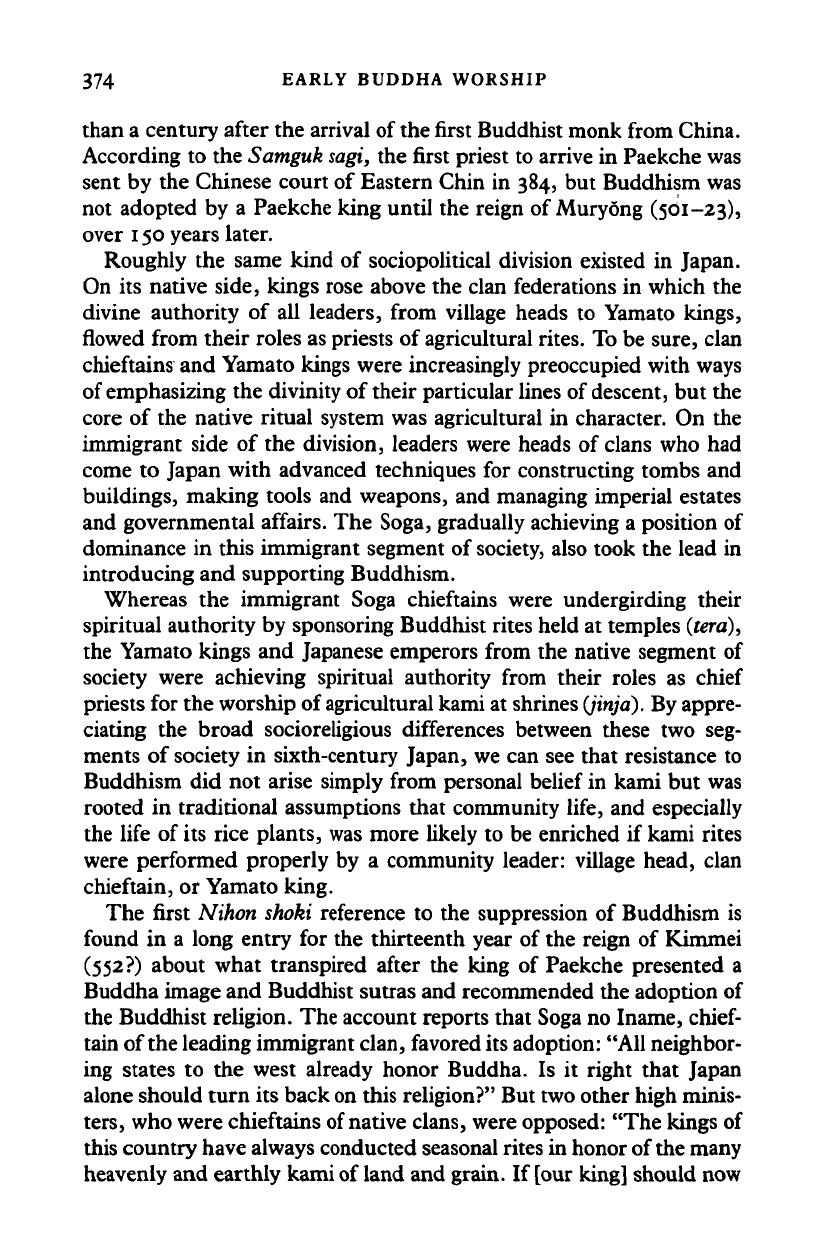
374 EARLY BUDDHA WORSHIP
than a century after the arrival of the first Buddhist monk from China.
According to the Satnguk
sagi,
the first priest to arrive in Paekche was
sent by the Chinese court of Eastern Chin in 384, but Buddhism was
not adopted by a Paekche king until the reign of Muryong (501-23),
over 150 years later.
Roughly the same kind of sociopolitical division existed in Japan.
On its native side, kings rose above the clan federations in which the
divine authority of all leaders, from village heads to Yamato kings,
flowed from their roles as priests of agricultural rites. To be sure, clan
chieftains and Yamato kings were increasingly preoccupied with ways
of emphasizing the divinity of their particular lines of descent, but the
core of the native ritual system was agricultural in character. On the
immigrant side of the division, leaders were heads of clans who had
come to Japan with advanced techniques for constructing tombs and
buildings, making tools and weapons, and managing imperial estates
and governmental affairs. The Soga, gradually achieving a position of
dominance in this immigrant segment of
society,
also took the lead in
introducing and supporting Buddhism.
Whereas the immigrant Soga chieftains were undergirding their
spiritual authority by sponsoring Buddhist rites held at temples
(tera),
the Yamato kings and Japanese emperors from the native segment of
society were achieving spiritual authority from their roles as chief
priests for the worship of agricultural kami at shrines
(jinja).
By appre-
ciating the broad socioreligious differences between these two seg-
ments of society in sixth-century Japan, we can see that resistance to
Buddhism did not arise simply from personal belief in kami but was
rooted in traditional assumptions that community life, and especially
the life of its rice plants, was more likely to be enriched if kami rites
were performed properly by a community leader: village head, clan
chieftain, or Yamato king.
The first Nihon shoki reference to the suppression of Buddhism is
found in a long entry for the thirteenth year of the reign of Kimmei
(552?) about what transpired after the king of Paekche presented a
Buddha image and Buddhist sutras and recommended the adoption of
the Buddhist religion. The account reports that Soga no Iname,
chief-
tain of the leading immigrant clan, favored its adoption: "All neighbor-
ing states to the west already honor Buddha. Is it right that Japan
alone should turn its back on this religion?" But two other high minis-
ters,
who were chieftains of native clans, were opposed: "The kings of
this country have always conducted seasonal rites in honor of the many
heavenly and earthly kami of land and grain. If [our king] should now
Cambridge Histories Online © Cambridge University Press, 2008
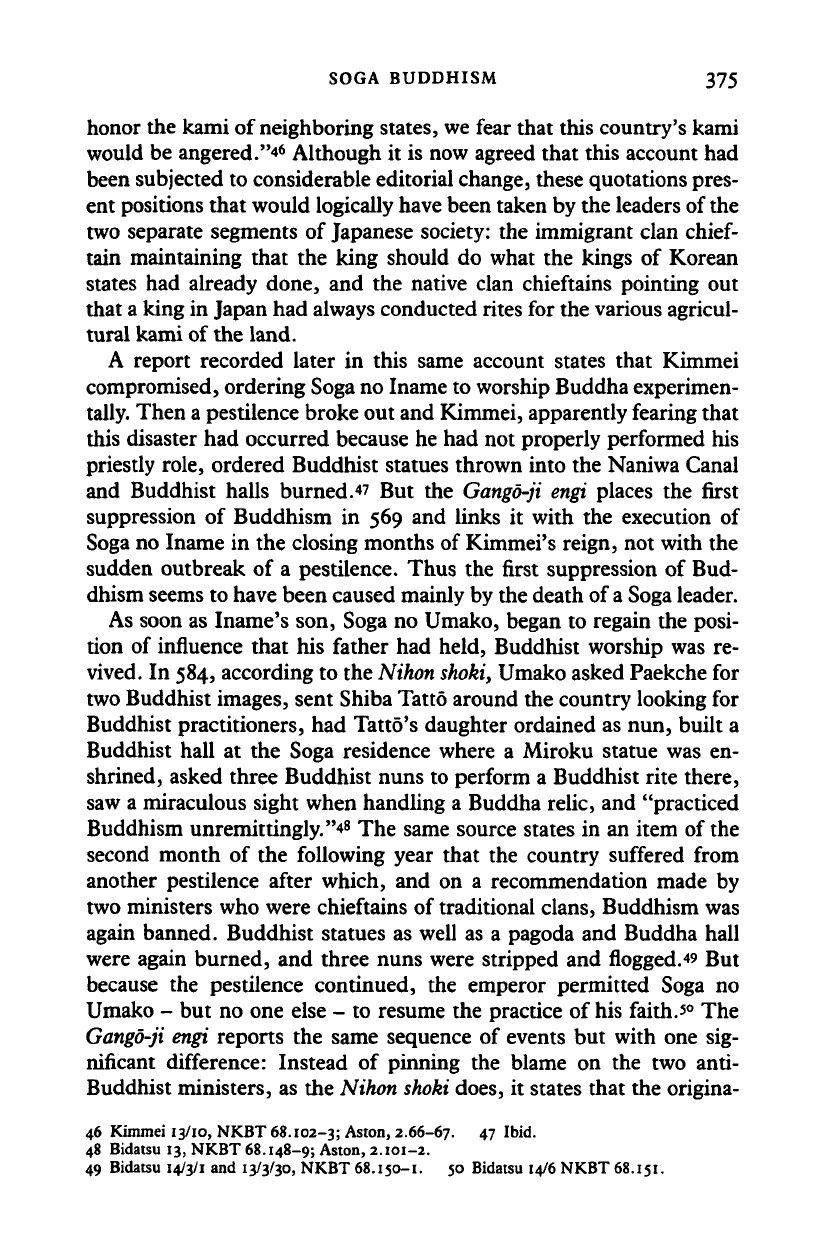
SOGA BUDDHISM 375
honor the kami of neighboring states, we fear that this country's kami
would be angered."*
6
Although it is now agreed that this account had
been subjected to considerable editorial change, these quotations pres-
ent positions that would logically have been taken by the leaders of the
two separate segments of Japanese society: the immigrant clan
chief-
tain maintaining that the king should do what the kings of Korean
states had already done, and the native clan chieftains pointing out
that a king in Japan had always conducted rites for the various agricul-
tural kami of the land.
A report recorded later in this same account states that Kimmei
compromised, ordering Soga no Iname to worship Buddha experimen-
tally. Then
a
pestilence broke out and Kimmei, apparently fearing that
this disaster had occurred because he had not properly performed his
priestly role, ordered Buddhist statues thrown into the Naniwa Canal
and Buddhist halls burned.
47
But the
Gango-ji
engi places the first
suppression of Buddhism in 569 and links it with the execution of
Soga no Iname in the closing months of Kimmei's reign, not with the
sudden outbreak of a pestilence. Thus the first suppression of Bud-
dhism seems to have been caused mainly by the death of
a
Soga leader.
As soon as Iname's son, Soga no Umako, began to regain the posi-
tion of influence that his father had held, Buddhist worship was re-
vived. In 584, according to the Nihon
shoki,
Umako asked Paekche for
two Buddhist images, sent Shiba Tatto around the country looking for
Buddhist practitioners, had Tatto's daughter ordained as nun, built a
Buddhist hall at the Soga residence where a Miroku statue was en-
shrined, asked three Buddhist nuns to perform a Buddhist rite there,
saw a miraculous sight when handling a Buddha relic, and "practiced
Buddhism unremittingly."-*
8
The same source states in an item of the
second month of the following year that the country suffered from
another pestilence after which, and on a recommendation made by
two ministers who were chieftains of traditional clans, Buddhism was
again banned. Buddhist statues as well as a pagoda and Buddha hall
were again burned, and three nuns were stripped and flogged.« But
because the pestilence continued, the emperor permitted Soga no
Umako - but no one else - to resume the practice of his faith.5° The
Gango-ji engi
reports the same sequence of events but with one sig-
nificant difference: Instead of pinning the blame on the two anti-
Buddhist ministers, as the Nihon
shoki
does, it states that the origina-
46 Kimmei 13/10, NKBT 68.102-3; Aston, 2.66-67. 47 Ibid.
48 Bidatsu 13, NKBT 68.148-9; Aston, 2.101-2.
49 Bidatsu 14/3/1 and 13/3/30, NKBT 68.150-1. 50 Bidatsu 14/6 NKBT 68.151.
Cambridge Histories Online © Cambridge University Press, 2008
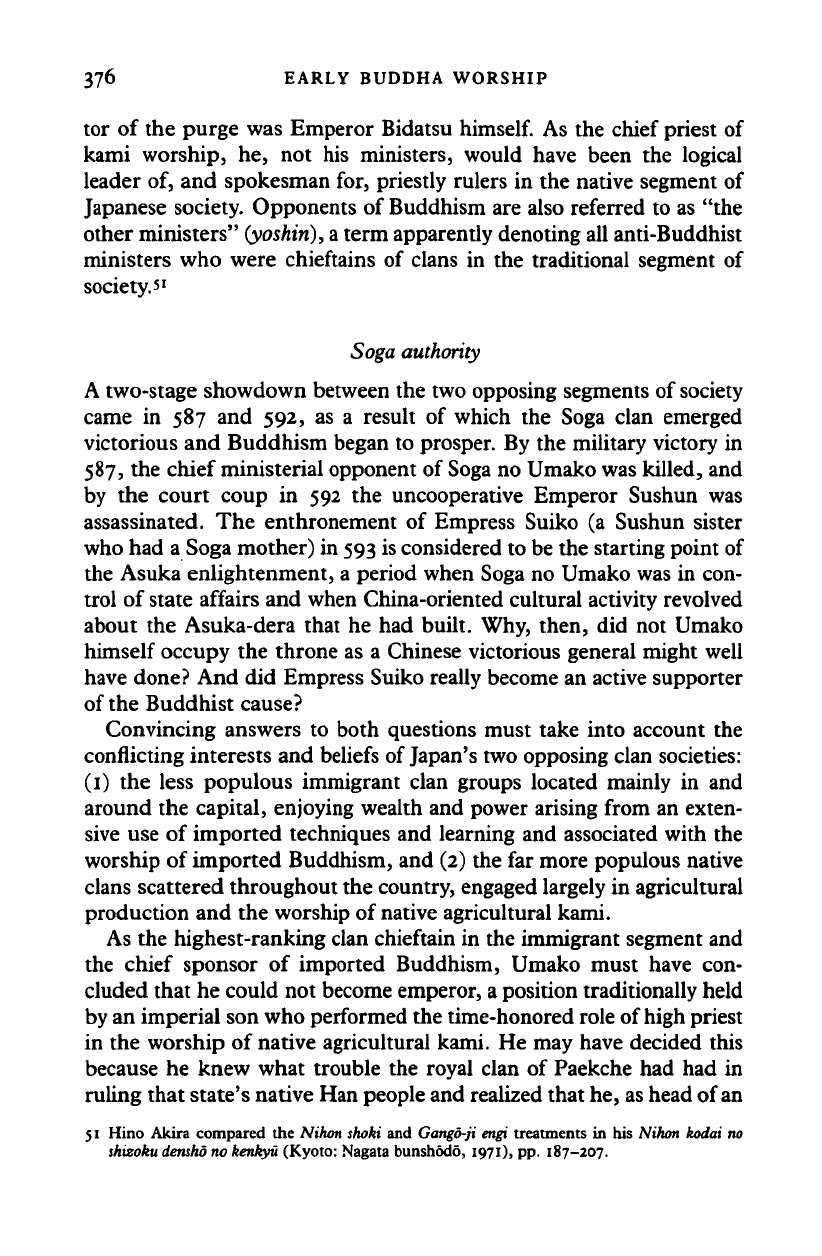
376 EARLY BUDDHA WORSHIP
tor of the purge was Emperor Bidatsu
himself.
As the chief priest of
kami worship, he, not his ministers, would have been the logical
leader of, and spokesman for, priestly rulers in the native segment of
Japanese society. Opponents of Buddhism are also referred to as "the
other ministers"
(yoshiri),
a
term apparently denoting all anti-Buddhist
ministers who were chieftains of clans in the traditional segment of
society.
5'
Soga authority
A two-stage showdown between the two opposing segments of society
came in 587 and 592, as a result of which the Soga clan emerged
victorious and Buddhism began to prosper. By the military victory in
587,
the chief ministerial opponent of Soga no Umako was killed, and
by the court coup in 592 the uncooperative Emperor Sushun was
assassinated. The enthronement of Empress Suiko (a Sushun sister
who had a Soga mother) in 593 is considered to be the starting point of
the Asuka enlightenment, a period when Soga no Umako was in con-
trol of state affairs and when China-oriented cultural activity revolved
about the Asuka-dera that he had built. Why, then, did not Umako
himself occupy the throne as a Chinese victorious general might well
have done? And did Empress Suiko really become an active supporter
of the Buddhist cause?
Convincing answers to both questions must take into account the
conflicting interests and beliefs of Japan's two opposing clan societies:
(1) the less populous immigrant clan groups located mainly in and
around the capital, enjoying wealth and power arising from an exten-
sive use of imported techniques and learning and associated with the
worship of imported Buddhism, and (2) the far more populous native
clans scattered throughout the country, engaged largely in agricultural
production and the worship of native agricultural kami.
As the highest-ranking clan chieftain in the immigrant segment and
the chief sponsor of imported Buddhism, Umako must have con-
cluded that he could not become emperor, a position traditionally held
by an imperial son who performed the time-honored role of high priest
in the worship of native agricultural kami. He may have decided this
because he knew what trouble the royal clan of Paekche had had in
ruling that state's native Han people and realized that he, as head of an
51 Hino Akira compared the Nihon shoki and Gango-ji engi treatments in bis Nikon kodai no
shizoku
densho
no kenkyu (Kyoto: Nagata bunshddd, 1971), pp. 187-207.
Cambridge Histories Online © Cambridge University Press, 2008
